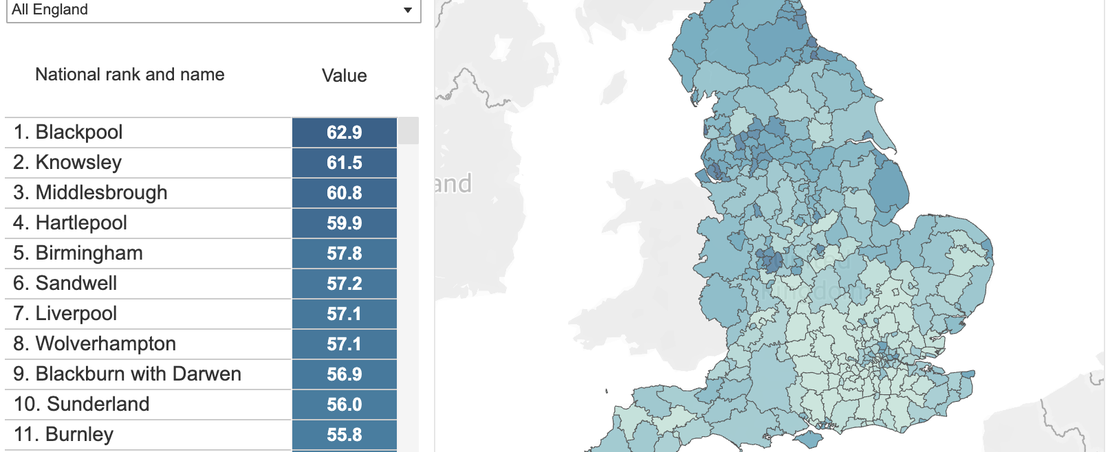
The first annual update to the Open Data Institute’s (ODI) Fuel Poverty Risk Index, published today, demonstrates the value of data infrastructure to help understand the scale and depth of fuel poverty across England. The Index combines more data than any other available for England. It scores each area across multiple indicators, including climate, income, deprivation, benefit receipt, and housing stock, to show the areas of highest need. The data analysis reveals a surprising picture of England.
- Wide geographic variations in fuel poverty continue across England. The ODI has identified the top ten local authorities for fuel poverty risk - the highest rises year-on-year are in the South East and South West of England. Fuel poverty increases in the South East may surprise many as the annual income measure used by the ODI’s index shows high average incomes in the area.
- The data in the ODI’s index demonstrates that fuel poverty across the UK has got worse in the last year, with the average fuel poverty risk index score across England increasing from 39.0 in 2022 to 41.2 in 2023. The top ten local authorities with the highest risk of fuel poverty have all seen their ODI index risk score increase year-on-year when comparing the 2022 and 2023 fuel poverty risk indexes.
- Just 15% of the 290 Local Authority Districts (LADs) analysed saw a year-on-year decrease in their fuel poverty risk.
- More than 3.6 million people are missing from the official data and potentially in fuel poverty due to the way fuel poverty is defined as only homes with an EPC rating of D or below, meaning that occupants of homes with a higher EPC rating are excluded even if they are struggling to pay energy bills.
- Government fuel poverty statistics continue to reflect wide geographic variations: the West Midlands and Yorkshire and the Humber have the highest proportion of households in fuel poverty (19% and 16% respectively) in England and higher than London at 13%.
- Based on the ODI’s fuel poverty risk index, for the second year running, households living in Blackpool have the highest propensity for fuel poverty.
The ODI’s Fuel Poverty Risk Index is a unique look at fuel poverty, drawing on 12 distinct datasets - and four supporting datasets - to help understand the scale and depth of fuel poverty across England. It allows users to compare data nationally and at local authority level and is free of charge for anyone to use.
The ODI’s latest data analysis - comparing its 2022 and 2023 fuel poverty risk indexes - updates on the ODI’s Fuel poverty and data infrastructure report and traces the impact of government intervention and payment schemes from 2022-2023, including the end of universal help in April 2023, on different local authorities in England.
The fuel poverty risk index is a data visualisation tool that highlights the impact of fuel poverty and drills down to local authority areas, showing which locations are at the most risk of fuel poverty. The 2023 index also reflects the increase in benefits claimed across England, where the average proportion of residents claiming Universal Credit increased from 13.2% in 2022 to 14.2% in 2023.
Official data is likely to significantly underestimate the number of people in fuel poverty. ODI analysis in September 2023 identified that as many as 3.6 million people are missing from the official data about fuel poverty, due to the way fuel poverty is defined in the Low Income, Low Energy Efficiency (LILEE) indicator. This specifies that only homes with an EPC rating of D or below can be counted, even if their occupants are struggling to pay their energy bills.
There is a greater need than ever for better data infrastructure to help address our most pressing challenges. The ODI believes that a strong, trustworthy data infrastructure is the lifeblood of the global economy, on a par with essentials like clean water and transport networks.
Head of Policy at the ODI
Many people will be unsurprised to see areas such as Blackpool continue to suffer fuel poverty, but without this sort of data analysis, agencies such as ours may be unaware that areas such as Torridge in Devon are also suffering. Continued access to high-quality open data would be useful, enabling us to make more informed decisions about how we plan and manage our resources to provide support where it is most needed.
Policy and Research Manager, Centrepoint
The data reveals that the energy crisis is far from over and is, in fact, getting worse. The analysis should highlight to the government and support agencies that further targeted support is urgently required during the coming cold winter months. The Index suggests a strong case for delivering long-term system reforms and improvements to the energy efficiency of buildings.
Co-ordinator of the End Fuel Poverty Coalition
The Fuel Poverty Risk Index is the ODI’s latest deep dive into the national data infrastructure around social challenges. In September 2023, the ODI published data analysis on ‘The cost of living: how data can help tackle the crisis’. Both pieces of analysis reveal gaps and inconsistencies in the data and disparities in how data is captured by different organisations. A national standard in data collection and better national data infrastructure would allow the government, local authorities, charities and other front-line services to cost effectively target help to those who need it most.